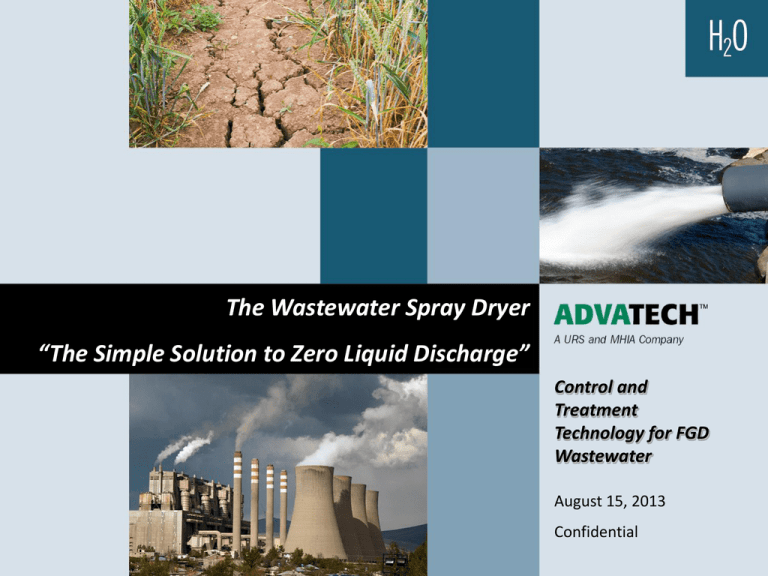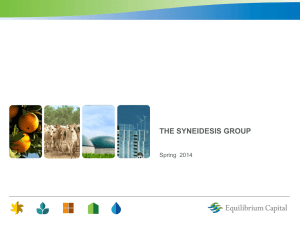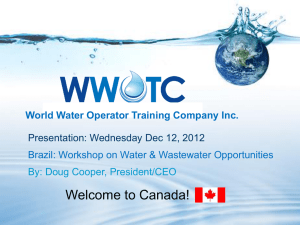by Norikazu Inaba, Advatech
advertisement

The Wastewater Spray Dryer “The Simple Solution to Zero Liquid Discharge” Control and Treatment Technology for FGD Wastewater August 15, 2013 Confidential Advatech ZLD offerings • Wastewater Evaporation System (WES) – Direct injection of wastewater into ductwork – Salts collected with fly ash in particulate control device – 10 commercial installations w/ 50 yrs of cumulative operating experience • Wastewater Spray Dryer (WSD) – Patented Process – Slipstream spray dryer bypassing air heater – Salts collected with fly ash in particulate control device – Application of MHI standard gas cooler design & WES experience 90 commercial installations, 20 years experience Truly Zero Liquid Discharge Technologies 2 Confidential WSD Overview Advantages 1. Differential pressure across heater provides motive force for flue gas passing through the WSD (no fan required) 2. Use of flue gas from upstream of the air heater reduces amount of gas required for evaporation 3. FGD wastewater is evaporated in a controlled environment that can be isolated for maintenance/repair 4. Salts & trace elements from wastewater are collected in the existing particulate control device for disposal, etc. with the fly ash 3 Confidential Typical WSD PFD for 500 MW Coal-fired Boiler 4% of Flue Gas Bypasses AH 3% Increase in Particulate Loading; ~0.4% Impact to Heat Rate 4 Confidential Possible concerns for WSD technology ?? • Evaporation CFD model for the wastewater – Affect the evaporation by wastewater composition ? • Captured in particulate control device – Can be corrected by particulate control device ? Verified by these questions by pilot testing 5 Confidential MHI’s Droplet Evaporation Model Droplet Temperature Droplet Drying process 4th step Boiling 5th step Drying 3rd step Crust Formation 1st step Initial Heating Up 2nd step Equilibrium Evaporation 1st step: Initial heating up by hot flue gas 2nd step: Evaporation at the wet bulb temperature with elevated boiling point 3rd step: Crust formation that inhibits water evaporation (droplet temperature increases) 4th step: Boiling remaining water 5th step: Drying solid Time Process of Solution Droplet Evaporation Droplet Evaporation Model Incorporated into CFD Software 6 Confidential Pilot Testing Purpose of Pilot Test • Verify the droplet evaporation model • Characterize the dried salt (sampling & SEM) Heated Simulated Flue Gas Two-Fluid Spray Nozzle Solution Solution Tank Pump Atomizing Air Compressor Schematic Drawing of Pilot Test Apparatus (Inlet Conditions: 630 scfm; 630oF) Photo of Typical Sampling Nozzle 7 Confidential Photo of Pilot Test Facility Pilot Test Results Testing Conditions Compositions of Salt Solution Case Case 1 Case 2 TDS 101,000 ppm Liquid Type Water Salt Solution Chloride 66,400 ppm Inlet Flow Rate 622 SCFM 628 SCFM L/G (gal/kacf) 0.34 0.34 Inlet Gas Temp 631F 635F Achieved Complete Evaporation for both cases Dried Salt Sample Photo of Dried Salt Sample SEM Photo of Dried Salt Sample Dried Salt Particle size : 10 – 60 micron Dried Salt Generated 8 Crust Formation Verified Confidential Pilot Test Results – CFD Model Evaluation CFD Result Vessel Center Spray Point Vessel Center Spray Point Wall Wall Vessel Center Spray Point Wall Temp [Deg F] 210 650 [Wet Salt] 650F 650F 200um 200 micron 16.5 16.5fps fps [Semi-Dry Salt] [Dry Salt] CFD Test data 210F 210F Gas GasTemperature Temperature Profile Profile 0 0 Droplet DropletSize Size Distribution Distribution 0 0 Gas GasVelocity Velocity • Both gas temp. and moisture content profiles in pilot vessel agreed with CFD model • Moisture content of collected dried salt also agreed with CFD model Droplet Evaporation Model effectively simulated evaporation process in WSD system 9 Confidential Typical Simulation for Droplet Tracing Larger Scale WSD for High-Cl Coal Application Rotary Atomizer (200 GPM) 10 Confidential Questions Cleared Up by Pilot Testing • Evaporation model simulates evaporation process – Gas temp., moisture content profiles in pilot testing agreed with CFD model • The Dried Salts should be Easily Captured by the Existing Particulate Control Device – Dried salt particle size in range of fly ash (10-60 um) 11 Confidential Commercial Design of WSD 29’ Height*) • Applied CFD model for commercial WSD design 11.5’ dia.*) Small Scale WSD for Low-Cl Coal Application (11 GPM) Larger Scale WSD for High-Cl Coal Application (200+ GPM) Larger Scale WSD is Commercially Available 12 Confidential Comparison of WSD to Traditional WWT 13 Confidential Summary • Patented WSD has been developed based on years of experience in the design / operation of WES and Flue Gas Cooler, and validated through pilot testing and CFD modeling • Due to its simplicity, the WSD is one of the most economically attractive ZLD options – Approximately 1/10th the cost of traditional WWT – Uses waste heat to evaporate the wastewater stream – Salt particles are collected in the existing particulate control device so a new waste stream is not generated • WSD can be applied for wide range of wastewater and even be used to reduce the amount of wastewater that goes to a more traditional wastewater treatment process • For more information, please visit www.AdvatechLLC.com 14 Confidential QUESTIONS? 15 Confidential









